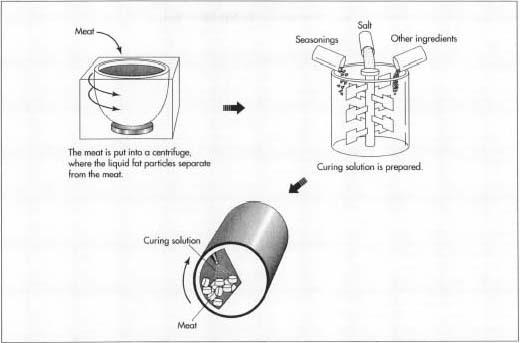Beef Jerky
Background
Beef jerky is a type of snack food that is made by marinating beef in a curing solution and drying it. Meat treated in this way has a long shelf life and a unique flavor. Invention of this meat processing technology is attributed to Native Americans who smoke-dried meat to preserve it. Beef jerky is part of the rapidly growing meat snack market which experienced yearly sales of over $240 million in 1996. This growth has been attributed to the healthy aspects of beef jerky such as its high protein content and low fat level.
Beef jerky is a specific type of a more general kind of meat snack called jerky. Jerky is any type of meat, which has been cured with a salt solution and has had the moisture reduced to less than 50% of the total. It is typically brown colored and has a rough texture. Compared to unprocessed meat, it is tougher and has a more powerful flavor. This is primarily due to the flavor concentrating effect of the moisture removal process. Beef jerky is promoted as a nutritious, low calorie product, which is low in cholesterol and fat and high in protein and energy.
To increase the consumer acceptance of the product, there are many different flavors of beef jerky that are produced. One of the most common is the pepper flavored jerky. Other types include teriyaki jerky, hot styles, and barbecue styles. Hickory smoked and maple spice flavors are also produced. In addition to these flavors, other meats are used in jerky making. Currently, the most popular jerky meat after beef is turkey.
History
Beef jerky is thought to have originated in South America during the 1800s. The Quechua tribe, who were ancestors of the ancient Inca empire, produced a meat similar to beef jerky called ch'arki, or charqui. It was made by adding salt to strips of muscle tissue from game animals such as deer, buffalo, and elk, and allowing them to dry in the sun or over fires for extended periods of time. This method of preparation enabled the people to preserve meats during times when it was readily available and eat it when food was scarce. When the Spanish encountered this method of meat preservation, they adopted it and made it available to the rest of the world. It became a staple foodstuff for American cowboys and pioneers. Early explorers built smoke huts and hung cuts of meat over a fire to smoke cure the meat. True jerky was made when the meat was first flavored and then cured. Over the years, people discovered that the meat could be made more palatable by the addition of various spices.
Raw Materials
The meat and a curing solution are all the components needed for making meat jerky. The primary starting material for making jerky is the meat. For the best tasting jerky, the beef used is range fed, 100% premium, visually lean, United States Department of Agriculture (USDA) inspected, flank steak. There are some manufacturers who produce a slightly different textured beef jerky using ground beef. In most cases, it requires over five pounds of meat to produce one pound of jerky. While most meat jerky is made using beef, various other types of meat are also used. Turkey has become popular because it is perceived as a healthier alternative to beef. It produces a jerky that is not as tough as beef jerky. Pork is another meat that is made into jerky. This jerky has a slightly different taste.
The curing solution is used to provide a better taste and a longer shelf life for the beef jerky. It is also responsible for the final color of the product. The cure solution also has an antimicrobial effect, which prevents the growth of harmful bacteria. A typical curing solution is composed of water and salt plus sodium nitrite. The salt has a dehydrating effect on the meat. The sodium nitrite helps to retard the development of rancidity and stabilizes the color. Sodium ascorbate may also be added to increase the pink color of the meat.
The curing solution is mixed with a brine, which is an aqueous solution of seasonings, spices, salt, sugars, and phosphates. Some common flavorants used include soy sauce, lemon juice, pepper, monosodium glutinate (MSG), or garlic powder. Worcestershire sauce is also used, as is teriyaki sauce. The sugars that are used to provide a level of sweetness include sucrose, dextrose, brown sugar, and dark corn syrup. Flavored salts such as hickory salt or onion salt are also included in the brine. Sodium phosphates may also be used. Some manufacturers use a material known as liquid smoke, which is made by dissolving smoke in water. This material gives the meat a smoke cooked taste without requiring smoke during cooking. Since jerky is very tough, a tenderizing agents such as polyphosphates or papin enzyme can be included. The use of these materials is limited however, because it increases the amount of time required for drying.
The Manufacturing
Process
While many different techniques can be used to make jerky, each have the primary steps of preparing the meat, soaking it in a curing solution, and cooking it until it is dried.
Initial meat preparation
-
1 Jerky can be prepared from either whole muscle or ground beef. In both
cases, the meat is first treated to remove the bones and connective
tissue, then the fat is removed. There are generally three methods for
defatting the meat. In one instance, the meat is put into a large
centrifuge. This device creates a spinning motion, which causes the
liquid fat particles to separate from the meat. In another method, the
meat is pressed to squeeze out all of the fat. Fat can also be removed
from the meat by filtering it.
In addition to deboning and defatting, the meat is subjected to other processes, which help remove foreign bodies and other unwanted materials. The meat is put on a conveyor and workers inspect it as it passes by. It may then be put on a metal screen and shaken to remove unwanted material. Other processes may include water separation and the removal of any metals via magnets. Some plants even use x-ray examination to ensure the purity of the meat prior to use.
Preparing the curing solution
- 2 While the meat is being processed, the curing solution may be prepared. This is typically done in a large tank equipped with mixing blades. Water is filled into the tank and the salt, seasonings, and other materials are mixed in. The solution is heated as required until it is ready to be used. Since some of the materials are not water soluble, it is often necessary to mix before use.
Meat processing and curing
-
3 At this point, the meat can either be frozen and cut up into chunks by
an automatic cutting machine or it can be ground up using a bowl
chopping machine. Using the frozen meat method, the meat is allowed to
partially thaw, which causes a release of the natural juices. The meat
can then be dipped in the curing solution. It must be left in for an
appropriately long time to allow total penetration of the liquid,
however, not so long as to risk meat contamination. Another method of
curing the meat is by injecting it with the curing solution by means of
a multi-needle device. Meat treated as such is then sent to a large,
stainless steel tumbling device that contains additional curing
solution. This helps tenderize the meat and ensures the total
penetration of the solution. If ground meat is used, the curing solution
can be mixed directly into the meat to produce a workable paste. While
ground meat is easier
to work with, it produces a jerky with somewhat undesirable characteristics.
 Once the meat is defatted, it is mixed with the curing solution.
Once the meat is defatted, it is mixed with the curing solution. - 4 After seasoning, the meat is molded into blocks and cooled to a temperature of 18-28° F (-8 - -2.2° C). When it is adequately frozen, it is sliced into strips. The strips are preferably cut in line with the fiber of the meat. This makes the final product have a more natural looking texture. These strips are then spread out onto wire mesh trays and sent to drying ovens to be cooked. Here the meat strips are heated to 160° F (71.1° C) and gradually cooled to about 90° F (32.2° C). Depending on the method by which the meat was initially prepared, cooking can take as long as 12 hours. During cooking, the moisture in the meat is reduced to 20-40%.
Packaging
- 5 Many different types of packaging are used for beef jerky. To preserve freshness, most jerky is packaged in a vacuum-sealed bag. One manufacturer uses a triple barrier bag in which the meat is put in, the package is evacuated, filled with nitrogen, and sealed. This method removes all oxygen from the system thereby preventing spoilage due to oxidation. Recently, manufacturers have introduced a resealable type package. These bags are initially vacuum sealed, but also have a zip lock so they can be closed after opening. After the individual meat pieces are packed, they are placed in boxes, put on pallets, and shipped via truck to retail stores.
Quality Control
In any food processing facility, quality control is extremely important. Governmental regulations require that certain minimum standards be met for any raw material that will be used. Meats in particular are heavily regulated because the use of poor quality meat represents a significant health risk. Most companies will use only high quality meat to assure their jerky is of similar quality. All the initial raw materials are checked prior to processing for such things as such as pH, percentage moisture, odor, taste, and appearance.

The Future
It is anticipated that future developments in meat jerky processing will be found in a few key areas. An important area of product development is focused on developing new flavors of meat jerky. This involves creating different recipes and using various kinds of meats. To further boost the image of meat jerky as a healthy snack, manufacturers will attempt to find ways of reducing the salt content of the final product. In the manufacturing area, a more continuous process is being developed. These techniques should result in more consistent product produced in a much shorter time period. Also, environmental concerns should lead to the development of waste-minimizing technologies.
Where to Learn More
Books
Bell, Mary. Just Jerky: The Complete Guide to Making It. Dry Store Publishing. 1996.
LeMaguer, M. and T. Jelen, editors. Food Engineering and Process Applications. London: Elsevier Applied Science Publishers, 1986.
Prowse, Brad. Jerky Making: For the Home, Trail, and Campfire. Naturegraph Publishing, 1997.
— Perry Romanowski
Comment about this article, ask questions, or add new information about this topic: